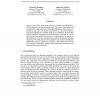Free Online Productivity Tools
i2Speak
i2Symbol
i2OCR
iTex2Img
iWeb2Print
iWeb2Shot
i2Type
iPdf2Split
iPdf2Merge
i2Bopomofo
i2Arabic
i2Style
i2Image
i2PDF
iLatex2Rtf
Sci2ools
NIPS
2003
2003
Probabilistic Inference in Human Sensorimotor Processing
When we learn a new motor skill, we have to contend with both the variability inherent in our sensors and the task. The sensory uncertainty can be reduced by using information about the distribution of previously experienced tasks. Here we impose a distribution on a novel sensorimotor task and manipulate the variability of the sensory feedback. We show that subjects internally represent both the distribution of the task as well as their sensory uncertainty. Moreover, they combine these two sources of information in a way that is qualitatively predicted by optimal Bayesian processing. We further analyze if the subjects can represent multimodal distributions such as mixtures of Gaussians. The results show that the CNS employs probabilistic models during sensorimotor learning even when the priors are multimodal.
| Added | 31 Oct 2010 |
| Updated | 31 Oct 2010 |
| Type | Conference |
| Year | 2003 |
| Where | NIPS |
| Authors | Konrad P. Körding, Daniel M. Wolpert |
Comments (0)

